TOP 20 MOST FAMOUS BUILDING DESIGNS OF THE WORLD
The world's most famous buildings can be a great source of inspiration for designers and artists. Whether it's the structural shapes, unique design concept or decorative details, buildings can provide ample inspiration for design projects of all kinds. Tourists travel the globe to seek out unique or historical architecture, and often visiting a famous building is one of the most memorable parts of a trip abroad.
A country's most famous buildings can tell us a lot about its way of life and the culture during the period when it was built; a bit like looking at a historical photograph. But unlike a photo, buildings continue to change after construction is finished. The usual wear and tear demands renovation and the changing tastes of society have their own impact on the design and functionality of a building.
In this article, we've rounded up some most incredible famous buildings for you to marvel at – these structures are amongst the most Instagrammable places in the world. You might want to plan visiting a few of them on your next trip. If so, make sure you brush up on your photography skills before you go, or perhaps try some of our top sketching tips so you can bring your own version home with you.
01. Sagrada Familia, Barcelona
Work started on Antoni Gaudí's Sagrada Familia in 1882, but Barcelona's most famous basilica is probably best known for not being finished – over 130 years later, the temple is still just 70 per cent complete. It has also only recently been issued a proper permit for construction, and is expected to be finished in 2026. Even while it's still under construction, this magnificent gothic building is well worth a visit.
02. Heydar Aliyev Center, Baku

The Heydar Aliyev Center is one of the most famous buildings designed by celebrated Iraqi-British architect Zaha Hadid. It's located in Baku, Azerbaijan, and is one of the newer designs on this list, having been completed in 2012. The design is noted for its distinctive, flowing lines and lack of sharp angles.
Zaha Hadid Architects was awarded the commission following a competition in 2007. On the practice's website, it explains the motivation behind the design: "The Center... breaks from the rigid and often monumental Soviet architecture that is so prevalent in Baku, aspiring instead to express the... optimism of a nation that looks to the future."
03. Cathedral of Brasilia, Brasilia
This curved beauty in Brazil's Brasilia is just as striking inside as outside with its beautiful stained glass and crown-like structure. It was created between 1958-1970 by Oscar Niemeyer and Lúcio Costa, who were known communists (an interesting point given the religious context). They rejected the trend for cube-like design favoured by their peers and celebrated the majesty of the curve.
04. Harpa Concert Hall, Reykjavik
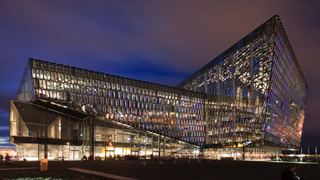
Harpa concert hall in Reykjavik was designed by Danish-Icelandic artist Olafur Elíasson alongside Henning Larsen Architects and Batteríið Architects. The kaleidoscope effect of the crystaline shell deploys light and colour that plays with your senses when you enter the building. It's a shimmering sculpture, sitting on the shoreline linking sky and sea.
05. Milwaukee Art Museum, Wisconsin
The Milwaukee Art Museum is an architectural landmark, comprised of three buildings. The War Memorial Center (1957) was designed by Finnish-American architect Eero Saarinen; the Kahler Building (1975) by David Kahler; and the Quadracci Pavilion (2001) by Spanish architect Santiago Calatrava.
Overlooking Lake Michigan, it’s linked directly to Wisconsin Avenue via a cable-stay footbridge. Pedestrians can cross Lincoln Memorial Drive on the bridge and continue into the pavilion, while drivers enter via an underground vaulted parking garage where pairs of canted concrete columns form a skeleton-like series of elements shaped like the letter ‘V’.
06. Forbidden City, Beijing

Less a famous building and more a series of famous buildings – 980, to be precise, constructed between 1406AD to 1420AD – the Forbidden City was home to Emperors from the Ming dynasty to the end of the Qing dynasty, making it the political centre of China for half a millennium.
The former imperial palace is now home to the Palace Museum, and was declared a World Heritage Site in 1987. The Forbidden City is listed by UNESCO as the largest collection of preserved ancient wooden structures in the world, and has seen an average of 16 million visitors every year since 2016 – that's an average of 40,000 visitors per day.
07. The Dancing House, Prague

Nicknamed The Dancing House, Prague’s Nationale-Nederlanden building was designed by Croatian-Czech architect Vlado Milunić and Canadian-American architect Frank Gehry.
The deconstructivist – or new-baroque – architecture forms an unusual dancing shape thanks to 99 concrete panels, each a different shape and dimension. It’s proved so popular that the building now features on a gold 2,000 Czech koruna coin issued by the Czech National Bank.
08. Great Mosque of Djenné, Djenné
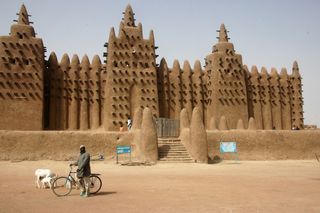
This mosque in Mali is one of the most famous buildings in Africa. It is thought that a mosque has existed on this site since the 1200s, and the current structure was rebuilt in 1907. Whether or not the mosque's current structure was influenced by French architecture (Mali became independent from France in 1906) has been subject to debate.
The building is made of earth bricks that have been dried in the sun, mortar made of sand and earth bricks, and a plaster that gives it its smooth surface. Once a year, the people of Djenné have a festival and work together to do any necessary repair work to the mosque. The mosque is so important in Mali that it features on the country's coat of arms.
09. Temple, New Dehli

The Lotus Temple is a Bahá'í House of Worship in New Delhi consisting of 27 structures resembling petals of the lotus flower that open onto a central hall around 40m high. It has nine sides, nine doors, and can accommodate 2,500 people. Its surface is made of white marble from Mount Pentelicus in Greece, the same marble used to build the Parthenon.
Since its completion in 1986 it has become one of the most visited buildings in the world, attracting over 100 million people.
10. Himeji Castle, Himeji
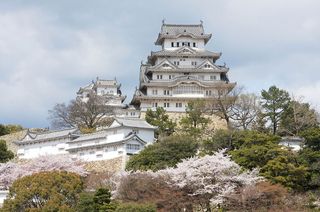
Himeji Castle is a spectacular Japanese castle located near Kyoto. It's over 400 years old and hasn't been damaged by war or any natural disasters, and is made up of over 80 buildings, which are all connected together by gates and winding paths.
This building is a marvel in itself, and is often called White Egret or White Heron Castle because of its white elegant exterior. It's also said to resemble a bird taking flight.
11. Cologne Cathedral, Cologne
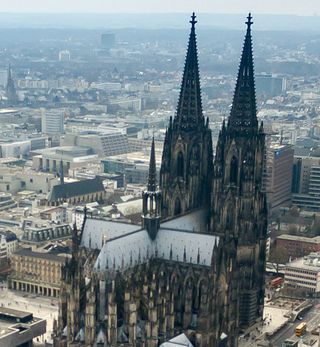
Cologne Cathedral is a High Gothic five-aisled basilica, the construction of which began in 1248 and stopped in 1473, before the building was complete. Work did not resume until the 1800s, and it was finally finished in 1880. Later work follows the original medieval plan faithfully.
It is renowned as a Gothic masterpiece and houses many works of art as well as the Shrine of the Three Kings, which is traditionally believed to hold the remains of the Three Kings.
12. Dome of the Rock, Jerusalem

A masterpiece of Islamic architecture, the Dome of the Rock is a 7th century building, located in Jerusalem. Built by Caliph Abd al-Malik between 687 and 691, the octagonal plan and the rotunda dome of wood are of Byzantine design. The Persian tiles on the exterior were added by Suleiman I in 1561; the interior decoration was added to later with marble, mosaic and faience.
The oldest extant Islamic monument, the Dome of the Rock has served as a model for architecture and other artistic endeavors for over a millennium.
13. La Pedrera, Barcelona
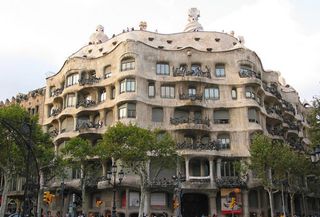
Nested among the urban streets of Barcelona are some unusual and beautiful buildings by infamous architect Antoni Gaudí. His unique approach to the Art Nouveau movement generated some of the most creative buildings the world have ever seen. And La Pedrera is no exception.
One of the most imaginative houses in the history of architecture, this is more sculpture than building. The façade is a varied and harmonious mass of undulating stone that, along with its forged iron balconies, explores the irregularities of the natural world. The United Nations Educational, Scientific and Cultural Organization (UNESCO) recognised this building as World Heritage in 1984.
14. St Paul's Cathedral, London
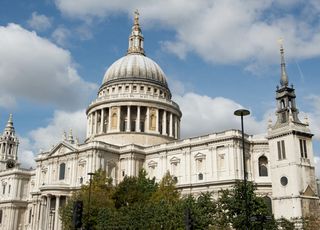
London's most iconic building, St Paul's Cathedral, was designed by English architect Sir Christopher Wren. Sitting at the top of Ludgate Hill, the highest point in the City of London, its famous dome is one of the world's largest, measuring nearly 112 metres high.
The original church on the site was founded in the year 604AD. Work on the present English Baroque church began in the 17th Century by Christopher Wren as part of a major rebuilding program after the Great Fire of London.
Wren started working on St Paul's in 1666, his designs for the cathedral taking nine years to complete and the actual construction taking a further 35 years. St Paul's has played an integral part of London life ever since – as a domineering element in the city's skyline, as a centre for tourism and religious worship, and most recently as a focal point for anticapitalist protests.
15. Petronas Towers, Kuala Lumpur
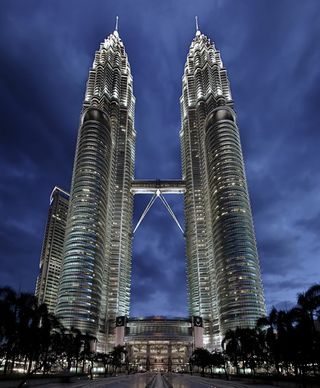
Standing at 451.9 metres-tall, the Petronas Towers are twin skyscrapers in Kuala Lumpur, Malaysia. The buildings, which held the title of tallest in the world between 1998-2004, are an iconic landmark of the capital city.
The distinctive postmodern style was created by architects Cesar Pelli and Achmad Murdijat, engineer Deejay Cerico and designer Dominic Saibo under the consultancy of JC Guinto.
16. The White House, Washington

Irish architect James Hoban was the man behind the design of the White House. In 1792 Hoban submitted a plan for the presidential mansion and subsequently got the commission to build the White House. Construction began in 1793 and was completed in 1801. The mansion, which has been home to every US leader since the country's second president John Adams, is made from white-painted Aquia sandstone.
17. Leaning Tower of Pisa, Pisa
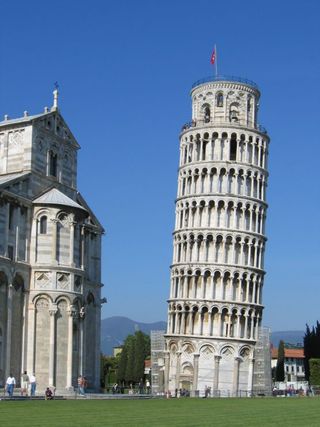
The Leaning Tower of Pisa is one of the most remarkable architectural structures in Europe. Most famous for its tilt, the tower began to lean during construction after soft ground on one side was unable to properly support the structure's weight.
Building work on the tower began in 1173 and went on for over a whopping 199 years. There has been much controversy surrounding the true identity of the architect behind the tower – the design was originally attributed to artist Bonnano Pisano but studies have also implicated architect Diotisalvi.
18. The Kaaba, Mecca
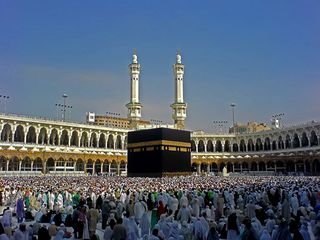
The Kaaba, meaning cube in Arabic, is a square building located in Mecca, Saudi Arabia. A most sacred place in Islam, the Kabba is elegantly draped in a silk and cotton veil. Every year millions of Muslims travel to the Kabba for the hajj, an annual Islamic pilgrimage to Mecca.
The small square building is about 45 feet high and its walls are a metre wide, with its total size occupying roughly 627 square feet.
19. The Shard, London

Also referred to as the shard of glass, The Shard is an 95-storey skyscraper, which sits in the heart of London. Construction began in 2009 and was completed three years later in 2012, making it Western Europe's tallest building.
Designed by architect Renzo Piano, The Shard is the second tallest free standing structure in the UK. It's exterior boasts 11,000 glass panels – that's equivalent in area to eight Wembley football pitches or two-and-a-half Trafalgar Squares.
The building was developed to have multiple uses, described on the website as a 'vertical city where people can live, work and relax'. This motto was clearly taken on board by a fox, nicknamed Romeo, that was found on the 72nd floor towards the end of construction.
20. Las Lajas Sanctuary, Nariño
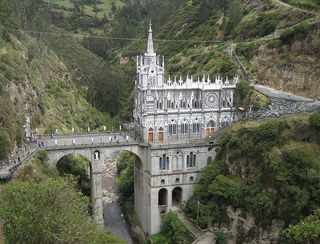
This church is built inside a canyon and connects one side of it to the other, if that isn't impressive, we don't know what is. This gothic-looking church is in Southern Colombia, the site where a woman and her daughter reportedly saw an apparition of the Virgin Mary in 1754, which made the previously deaf and mute daughter able to speak.
Since then, various shrines have been built, and the current construction was created between 1916-1949.







Comments
Post a Comment
For any questions feel free to ask me.